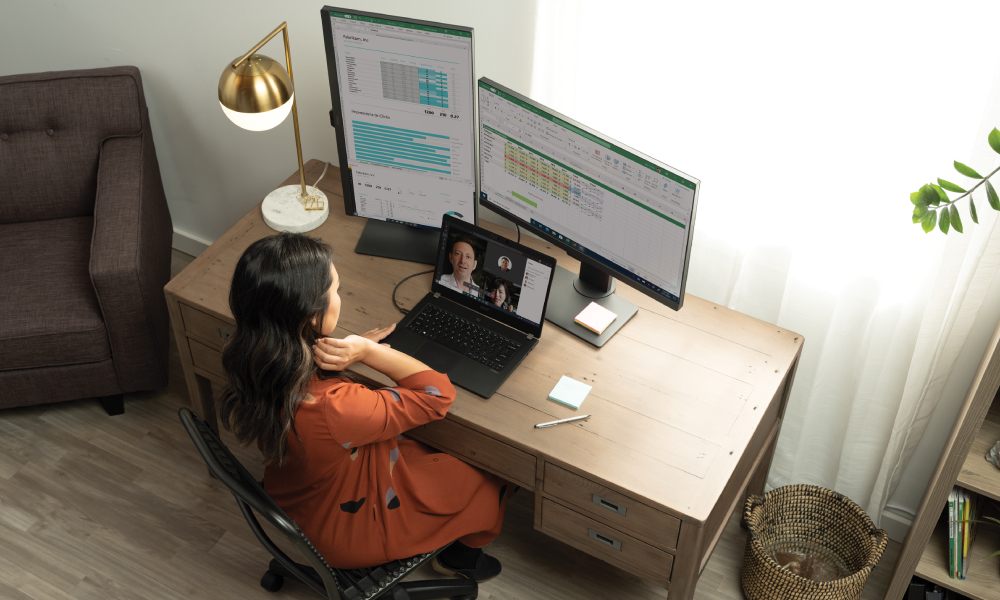It’s critical that employers leverage the right technology to boost employee engagement

With millions of people still working from home more than a year into the pandemic — and potentially beyond — it’s critical that employers leverage the right technology to boost employee engagement
As a human resources leader, Carolyn Byer constantly thinks about how best to address flagging employee engagement as the COVID-19 pandemic stretches on and the challenges that come with remote work persist. More than a year into working from home, it’s critical for organizations to leverage the right technology to boost employee engagement as leaders reckon with what the future of work will look like, says Byer, head of HR at Microsoft Canada.
“At this point in the pandemic, much of our focus has been centred around combatting digital exhaustion in the workplace,” says Byer, noting that research in this year’s Work Trend Index — an annual report from Microsoft providing data-driven insight into workplace trends — shows the digital intensity of the average worker’s day has increased substantially, especially around meetings and chats.
“When people are constantly plugged in, it can lead to increased employee fatigue, anxiety and higher burnout rates, which, in turn, does have an impact on employee motivation and engagement,” she says.
Addressing digital exhaustion is a priority not just for Microsoft employees, but also for the customers it supports, and there are a few things HR leaders can do. One is implementing ruthless prioritization — looking at the demands on employees and finding ways to take things off their plates. For example, with working from home, the default has been to set up a call for everything, but other technology should be considered, says Byer.
“It’s about being more dynamic and creative in the way you do your work, and leveraging technology to streamline the day,” she says, noting that employees at Microsoft use Microsoft Teams and leverage Teams channels and email instead of a call when appropriate.
Microsoft Teams also has features to help develop employee mental health and well-being. One allows employees to schedule a virtual commute, which recreates the structure that physical commutes lent to a workday. And, to embrace a culture where breaks are encouraged and respected, Microsoft has partnered with Headspace, a global leader in mindfulness and meditation, so employees can schedule breaks throughout the day.
The pandemic has brought to light the need to focus on mental health, says Byer. With many anticipating hybrid work as the new normal, it’s critical that organizations work to build social capital by investing in space and technology to bridge the gap between the physical and digital worlds and meet the unique needs of every team. To be successful, the technology must allow people to fully participate from home, in the office or on the go.
For Byer, who misses face-to-face interaction and believes there’s so much gained from in-person collaboration, this includes creating inclusive meeting experiences where everyone can contribute.
“One thing I personally love is the idea of putting your hand up when you’re on a big call — you might try to break in with an idea or a question and may not be heard, or like me, you may be more on the introverted side of things, so the hands-up function on Teams flags to others that you have a point to make, and that, to me, is a great example of more inclusive technology.”
Another helpful feature is the chat on the side of the video call, which gives those not comfortable with speaking up the ability to participate.
“Organizations need to be thinking about things like this,” says Byer, adding that employee engagement has changed dramatically over the past year, “and we’ll want take many of the learnings from this year as we move forward.”
With tools like the newly introduced Microsoft Viva — an employee experience platform that brings together communications, knowledge, learning, resources and insights to foster a culture where people and teams are empowered to be their best from anywhere — resources will be served directly to the employee and curated to their needs. “That’s our way of customizing, personalizing and really putting the employee experience at the centre,” says Byer.
In a hybrid world where people aren’t collaborating and connecting like they would in a physical office, it’s important to find ways to increase engagement and support well-being among teams — and the only way to do that is by rebuilding social capital, because, especially in these times, “culture isn’t a nice to have; it’s a business imperative,” says Byer.
It’s about leading from the top, having engaged leaders and ensuring employees understand the importance of self-care in the workplace — and have the tools to come together as a team to collaborate, she says.
“Every organization needs to take a good hard look at the technology they’re using from a productivity and wellness standpoint — and make sure those systems of support stay in place well beyond the pandemic.”
For more information, visit aka.ms/workunplugged.





